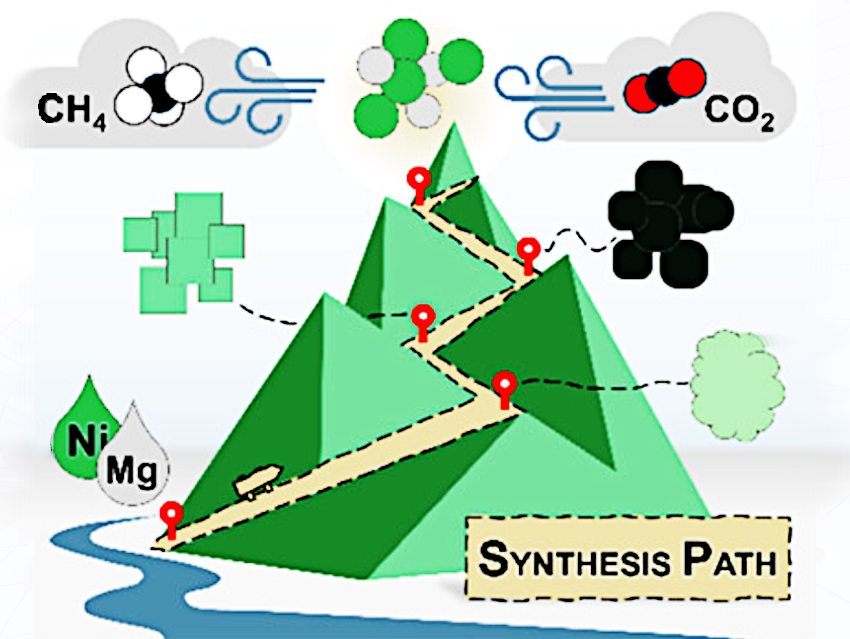The energy transition requires not only new energy sources but also efficient ways to store and transport energy. Malte Behrens and colleagues at Kiel University (CAU), Germany, have developed a catalyst that can convert CO₂—one of the most important greenhouse gases—into methane. This gas serves as a versatile energy carrier and can be directly fed into existing natural gas networks. The new catalyst is inexpensive, durable, and outperforms materials currently used in industry.
The underlying Power-to-Gas (PtG) concept stores renewable energy in chemical form. Using electricity, the researchers first generate hydrogen and then react it with CO₂ to form methane. Under real-world conditions, the reaction mixture fluctuates due to varying electricity supplies from wind and solar energy. The team, therefore, used a catalysts that performs reliably even under such variable conditions.
The team adapted a proven concept for the new catalyst by combining nickel and magnesium at the atomic level. They synthesized a crystalline bimetallic single-source precursor, (Ni₁–ₓMgₓ)₁₂(CO₃)₈(OH)₆O·yH₂O (with x = 0–0.5), which can be converted into a highly active Ni/MgO CO₂ methanation catalyst. All stages of preparation—coprecipitation, crystallization, calcination, and reduction—were comprehensively analyzed using powder X-ray diffraction, physisorption, transmission electron microscopy, and other techniques.
This controlled co-crystallization forms a solid solution that, just before the actual reaction in the reactor, separates into tiny nickel particles stabilized by magnesium oxide. During reduction, the oxide solid solution Ni₁–ₓMgₓO separates into metallic Ni and Ni-depleted oxide, forming a highly porous, finely interdispersed nanostructure of both components. The magnesium oxide enhances CO₂ adsorption, making the reaction particularly efficient, while the nickel nanoparticles remain evenly distributed and strongly supported, which significantly promotes methane formation.
The scalable synthesis yields unusually high surface areas of around 230 m²g⁻¹ for the calcined precatalyst Ni₁–ₓMgₓO. A high methane production rate is achieved in a CO₂/H₂ (1:4) feed at high space velocities of approximately 150 L h⁻¹g⁻¹. The performance is competitive with that of industrial methanation catalysts and depends strongly on the Ni:Mg ratio used in synthesis, according to the researchers. For an equimolar ratio, the new catalyst is four times as active as the industrial benchmark. Moreover, the nanoscaled microstructure stabilizes very high Ni loadings (up to 77 wt%) with only minor sintering effects at reaction temperatures of 240–280 °C.
The team found that even at relatively low temperatures of 260 °C, the catalyst converts large amounts of CO₂ into methane. In practical terms, just one kilogram of the material can produce enough methane in less than a week to heat a single-family home for an entire year.
By bridging the gap between thermally unstable Raney-type and conventional lower-loaded impregnated industrial catalysts, this material represents a significant step forward in sustainable energy conversion. The researchers are now scaling up their laboratory results and testing the catalyst under real PtG conditions together with partners at the University of Hamburg, Germany.
- A Novel Coprecipitation Path to a High-Performing Ni/MgO Catalyst for Carbon Dioxide Methanation,
Anna Wolf, Michael Chumakovski, Hauke Rohr, Patrik Hauberg, Morteza Saedi, Sebastian Mangelsen, Malte Behrens,
ChemSusChem 2025.
https://doi.org/10.1002/cssc.202502052
The text is based on the press release
- Katalysator aus Kiel macht Treibhausgas zum Energieträger
- Catalyst from Kiel Turns Greenhouse Gas into Energy Carrier




